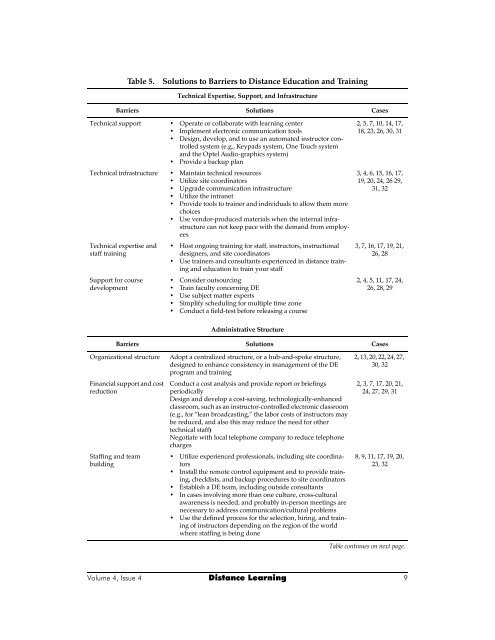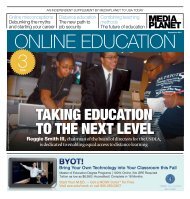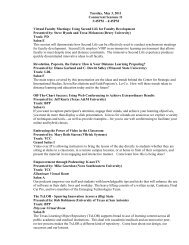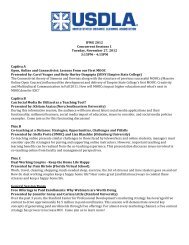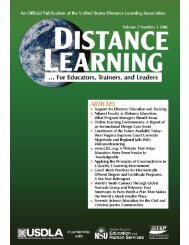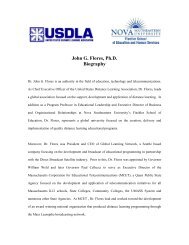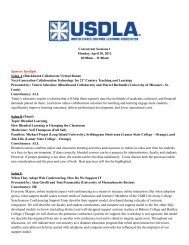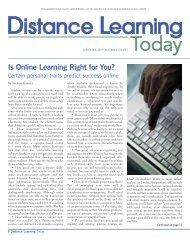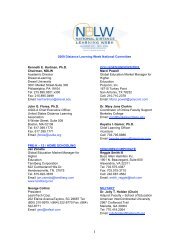United States Distance Learning Association
United States Distance Learning Association
United States Distance Learning Association
- No tags were found...
You also want an ePaper? Increase the reach of your titles
YUMPU automatically turns print PDFs into web optimized ePapers that Google loves.
Table 5.<br />
Solutions to Barriers to <strong>Distance</strong> Education and Training<br />
Technical Expertise, Support, and Infrastructure<br />
Barriers Solutions Cases<br />
Technical support • Operate or collaborate with learning center<br />
• Implement electronic communication tools<br />
• Design, develop, and to use an automated instructor controlled<br />
system (e.g., Keypads system, One Touch system<br />
and the Optel Audio-graphics system)<br />
• Provide a backup plan<br />
Technical infrastructure • Maintain technical resources<br />
• Utilize site coordinators<br />
• Upgrade communication infrastructure<br />
• Utilize the intranet<br />
• Provide tools to trainer and individuals to allow them more<br />
choices<br />
• Use vendor-produced materials when the internal infrastructure<br />
can not keep pace with the demand from employees<br />
Technical expertise and<br />
staff training<br />
Support for course<br />
development<br />
• Host ongoing training for staff, instructors, instructional<br />
designers, and site coordinators<br />
• Use trainers and consultants experienced in distance training<br />
and education to train your staff<br />
• Consider outsourcing<br />
• Train faculty concerning DE<br />
• Use subject matter experts<br />
• Simplify scheduling for multiple time zone<br />
• Conduct a field-test before releasing a course<br />
2, 5, 7, 10, 14, 17,<br />
18, 23, 26, 30, 31<br />
3, 4, 6, 15, 16, 17,<br />
19, 20, 24, 26 29,<br />
31, 32<br />
3, 7, 16, 17, 19, 21,<br />
26, 28<br />
2, 4, 5, 11, 17, 24,<br />
26, 28, 29<br />
Administrative Structure<br />
Barriers Solutions Cases<br />
Organizational structure<br />
Financial support and cost<br />
reduction<br />
Staffing and team<br />
building<br />
Adopt a centralized structure, or a hub-and-spoke structure,<br />
designed to enhance consistency in management of the DE<br />
program and training<br />
Conduct a cost analysis and provide report or briefings<br />
periodically<br />
Design and develop a cost-saving, technologically-enhanced<br />
classroom, such as an instructor-controlled electronic classroom<br />
(e.g., for “lean broadcasting,” the labor costs of instructors may<br />
be reduced, and also this may reduce the need for other<br />
technical staff)<br />
Negotiate with local telephone company to reduce telephone<br />
charges<br />
• Utilize experienced professionals, including site coordinators<br />
• Install the remote control equipment and to provide training,<br />
checklists, and backup procedures to site coordinators<br />
• Establish a DE team, including outside consultants<br />
• In cases involving more than one culture, cross-cultural<br />
awareness is needed, and probably in-person meetings are<br />
necessary to address communication/cultural problems<br />
• Use the defined process for the selection, hiring, and training<br />
of instructors depending on the region of the world<br />
where staffing is being done<br />
2, 13, 20, 22, 24, 27,<br />
30, 32<br />
2, 3, 7, 17, 20, 21,<br />
24, 27, 29, 31<br />
8, 9, 11, 17, 19, 20,<br />
23, 32<br />
Table continues on next page.<br />
Volume 4, Issue 4 <strong>Distance</strong> <strong>Learning</strong> 9


